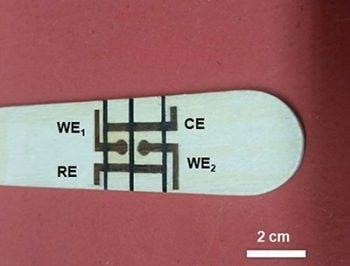Tongue depressors are frequently used by doctors when peering into a patient’s mouth and throat. However, a study has determined whether this flat wooden spatula could actively assess a patient's health.

Electrochemical cells etched by a laser on a wooden tongue depressor can measure glucose and nitrite levels in saliva. (WE = working electrode, CE = common counter electrode, RE = common reference electrode) Image Credit: Adapted from Analytical Chemistry, 2023, doi.org/10.1021/acs.analchem.3c01211
Researchers have developed an eco-friendly disposable sensor, reported in ACS’ Analytical Chemistry, that checks levels of glucose and other biomarkers present in saliva. The easy-to-produce device could help doctors evaluate a range of conditions.
Wood is known as a biodegradable, renewable, and natural material that has been extensively available at reduced prices, making it appealing for scientists who develop sensors and electronics. However, this is difficult since the material is not good at conducting electricity.
One solution is to use wood as a passive substrate and further coat it with metals and carbon-based inks. Instead, high-power lasers could scorch particular regions on the wood, converting those spots into conductive graphite.
However, this complicated method needs advanced and costly instrumentation, fire retardants, and an oxygen-free atmosphere. For a cheaper and more straightforward process to be developed, Christos Kokkinos and collaborators converted to low-power diode lasers, which have been successfully utilized to make polyimide-based sensors but have not been employed in electrochemical sensors and wooden electronics.
The team used a portable, inexpensive laser engraver to make a pattern of conductive graphite electrodes on a wooden tongue depressor without requiring unique conditions. Such electrodes developed two electrochemical cells isolated by lines drawn with a water-repellent permanent marker.
The biosensor was utilized to quickly and concurrently quantify concentrations of glucose and nitrite in artificial saliva. Nitrite can potentially disclose oral diseases, such as periodontitis, while glucose could act as a diagnostic for diabetes.
The scientists say such affordable devices can be adapted to detect other saliva biomarkers and would be simple and rapid to produce on-site at medical facilities.
Journal Reference
Koukouviti, E., et al. (2023) Wooden Tongue Depressor Multiplex Saliva Biosensor Fabricated via Diode Laser Engraving. Analytical Chemistry. doi.org/10.1021/acs.analchem.3c01211.